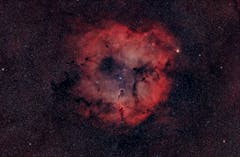Astronomik H-alpha 12nm CCD MaxFR Clip-Filter EOS APS-C
MaxFR Astronomik photographic narrowband-emission line filters for fast optical systems.
There is an ever-growing demand for filters suitable for extremely fast optical systems like Celestron’s RASA and Takahashi Epsilon Astrographs.
Our novel MaxFR emission line filters are suitable for very fast focal ratios. The new Astronomik MaxFR series of narrowband-emission line filters is perfectly matched to the requirements of astronomical deep-sky imaging with fast optical systems. For the three most important emission lines of oxygen (OIII), hydrogen (H-alpha), and sulfur (SII), you may select your filters with either 12nm or 6nm Bandwidth (FWHM).
MaxFR OIII-CCD filter
6nm and 12nm FWHM
MaxFR H-alpha-CCD filter
6nm and 12nm FWHM
MaxFR SIII-CCD filter
6nm and 12nm FWHM
Highest transmission:
Our new MaxFR filters are designed for fast optical systems, featuring MFR Coating technology that provides the best out-of-band blocking possible across the entire range of wavelengths from the UV to IR. The design ensures extremely high contrast, minimized stray light, no halos, and needle-sharp stars. Astronomik MFR filters give you the best quality data for post-processing into stunning final images.
- 12nm MaxFR filters: Usable from f/1.7 to f/8 with about 85% maximum transmission at f/1.4.
- 6nm MaxFR filters: Usable from f/2.2 to f/8 with about 90% maximum transmission at f/2.
Imaging with Narrowband-Emission Line Filters:
When observing from light-polluted locations, narrowband-emission line filters are your best tool for capturing amazing deep-sky images. Using an H-alpha filter enables deep, high-contrast images even under heavy light pollution or during a full moon. H-alpha filters are ideal for imaging nebulae that glow red, while an OIII filter lets you capture greenish-blue structures like planetary nebulae. The SII filter completes the HSO set, allowing you to process images like the Hubble Space Telescope!
Quality aspects of the new Astronomik MFR narrowband-emission line filters:
- MFR Coating: 12nm filters work down to f/1.4, and 6nm filters down to f/2.
- High-Quality Substrate: Optically polished glass, made with stress- and striae-free materials.
- Parfocal Filters: All Astronomik filters are parfocal, ensuring no shift in the focal plane when changing filters.
- Durability: Highly scratch-resistant and unaffected by humidity or aging, these filters maintain their performance over many years.
- Integrated Blocking: Full blocking of unwanted light across the UV to IR spectrum, so no additional UV/IR blocker is needed.
- Available Sizes: From 1.25" up to 50mm x 50mm square filters.
- Comes in a high-quality protection & storage box.
- 10-year guarantee on all filters.
With Astronomik filters, you get the highest quality possible for astrophotography, especially when dealing with light pollution. These filters will continue to perform as well as new even after years of use. Thanks to the MFR coating, they are compatible with nearly any instrument you may use.
FAQs:
- Which is better, 12nm or 6nm?
If you have a camera with low dark current and effective cooling, 6nm filters offer better blocking of background light and enable deeper exposures. For DSLR and dark-current-limited cameras, 12nm filters are the better choice.
- How does using these filters affect exposure time?
While you don’t have to expose longer with a narrowband filter, you can do so to capture fainter structures. These filters block unwanted light while allowing nearly all emission line photons to pass through. By reducing the background signal, they enable longer exposures, potentially up to 30 minutes, to reveal more details.








